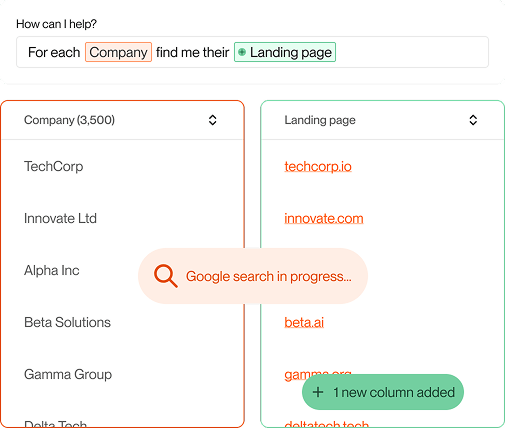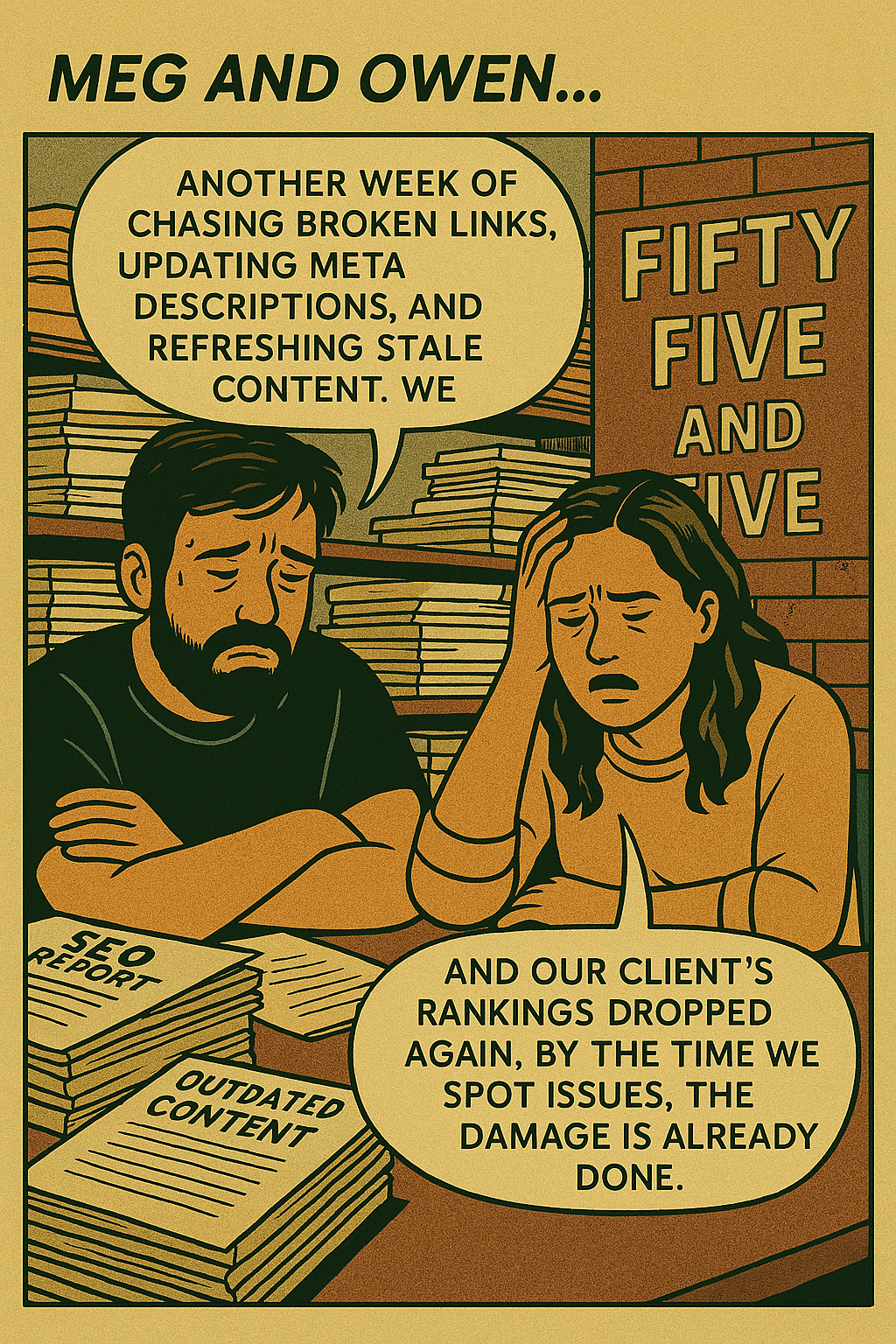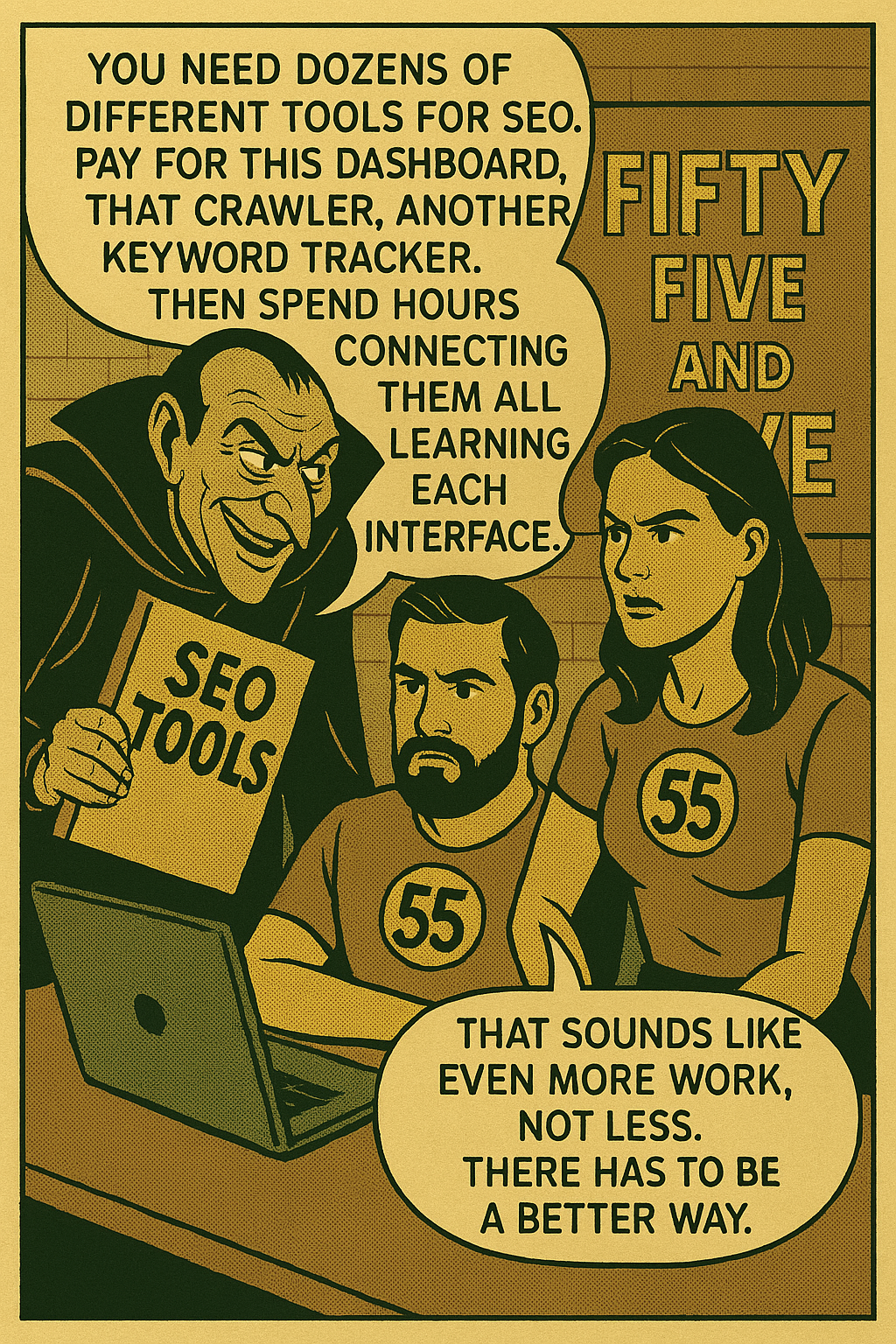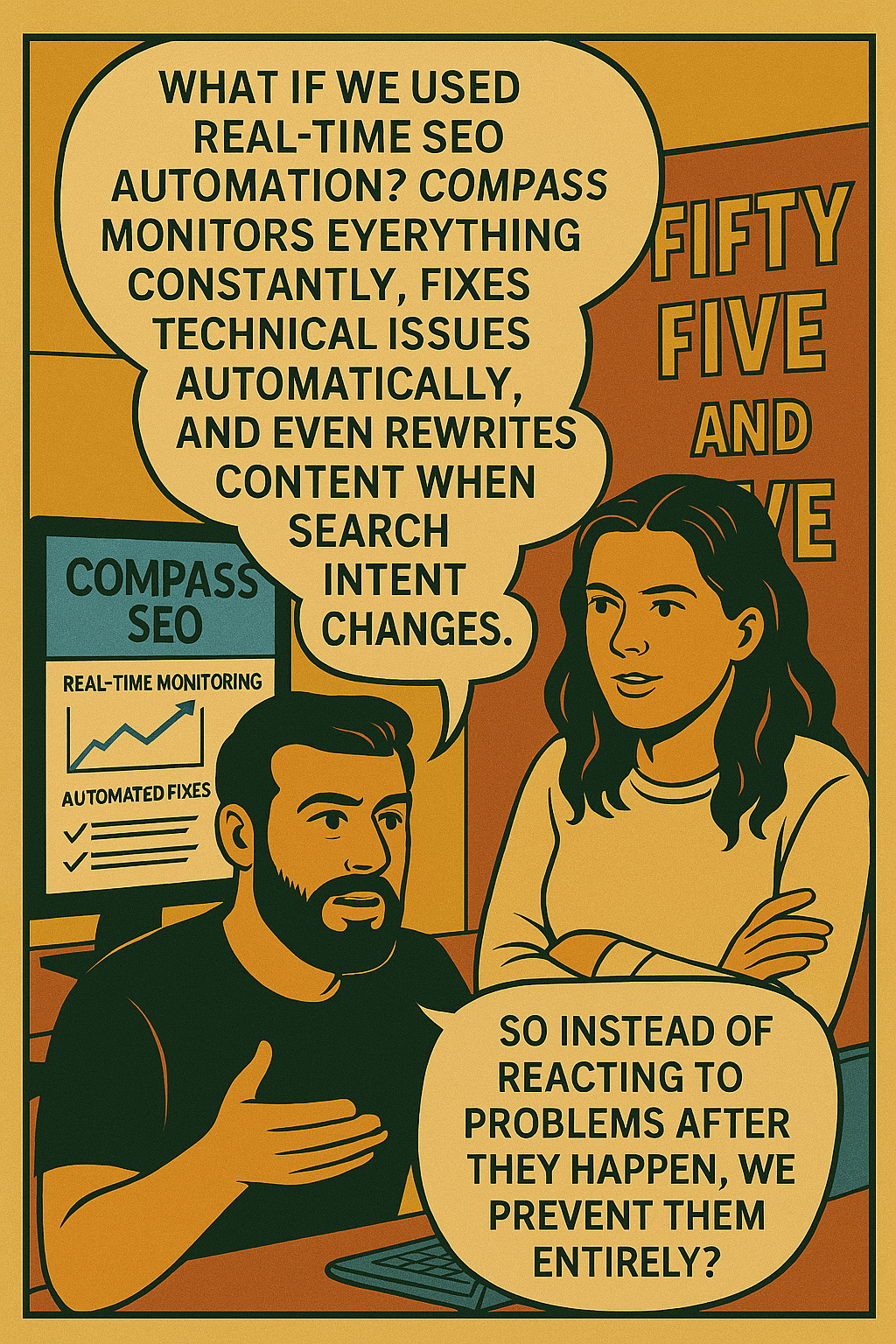Your top to bottom SEO automation guide for 2025.
What it is, what to automate, and how to do it well
Last edited: 16th April 2025 - Written by Megan Rudd
What is SEO automation?
SEO automation is using software to handle the parts of SEO that don’t need a human. That’s the short version.
But let’s be clearer: it’s not just about saving time. It’s about keeping up. Search engines update constantly. New competitors appear overnight. Your content gets stale without anyone noticing. Most in-house teams can’t respond fast enough. Automation helps close that gap.
You’ve probably already used automation, even if you didn’t call it that. Setting up a scheduled crawl in Screaming Frog? Automation. Running a weekly dashboard report from GA4? Automation. What’s changing now is the scope. And the intelligence.
Automation today can mean:
-
tools that rewrite your meta descriptions in real time
-
platforms that track every keyword movement across thousands of pages
-
scripts that monitor site changes and trigger SEO fixes instantly
-
AI models that cluster keywords by meaning, not just match
We’re no longer just automating “tasks.” We’re starting to automate judgement. Not perfectly, but fast enough that it’s useful.
The old model: manual SEO
Manual SEO is slow. It’s built around checklists and reviews. You write a blog, then optimise it. You notice a drop in rankings, then investigate. You fix broken links once someone complains.
It works. But it’s reactive. And over time, you spend more energy keeping the engine running than moving forward.
The new model: SEO in real time?
You don’t wait for rankings to drop, you spot changes as they happen. You don’t guess what to optimise, you know, because the data updates constantly. That’s the real promise of automation: not just speed, but timing.
Most teams aren’t there yet. They’re somewhere in the middle. Maybe they’ve automated audits. Maybe they use AI for content briefs. Maybe they’re testing programmatic pages.
What matters is this: the more you automate the routine parts of SEO, the more time you free up for work that actually drives traffic, strategy, insight, and content that says something real.
Automation isn’t the strategy. But it’s how you make strategy possible.
While we're here, want to know our thoughts (in greater detail) on how AI could change SEO?
Why automate SEO?
It's worth repeating, most SEO teams aren’t short on knowledge. They’re short on time.
The tools have improved. The search landscape hasn’t gotten any simpler. You still have to deal with the same messy list: keyword gaps, technical debt, outdated content, unexplained traffic drops.
And when you're running a site with hundreds—or thousands—of pages, manual SEO just doesn’t scale.
Here’s why automation is no longer optional for modern teams.
1. Time savings where it counts
Fixing metadata. Spotting and fixing broken links. Checking for indexing issues. Tasks that happen daily, but no one sees, unless something breaks.
These things need to be done. But they don’t need to be done by hand.
When you automate them, you free up hours, even days, that can go to better use: strategy, content planning, testing, outreach.
2. Faster response to change
Google’s algorithm updates constantly. Competitor rankings shift daily. Search trends move fast.
Manual SEO means you’re always reacting. Automation means you can keep up or get ahead.
An automated SEO stack flags changes as they happen:
-
rankings drop → metadata is refreshed
-
broken links → auto-redirected
-
keyword intent shifts → new content triggered
You don’t fall behind because you’re not waiting on a monthly audit to tell you something broke three weeks ago.
3. Less room for human error
SEO involves detail. And repetition. That’s a bad combo for humans.
Mistakes creep in, missed redirects, duplicate content, outdated sitemaps. With automation, you’re not relying on someone to remember to run the report or update that one field. It just happens.
More consistency. Less firefighting.
4. Smarter prioritisation
Most SEO work gets done late. After the dev sprint. After the blog goes live. After someone notices a problem.
With the right automation, you shift from post-mortem SEO to proactive SEO. You catch issues before they impact rankings. You optimise content before it slips out of relevance. You get ahead of competitor moves instead of reacting to them.
5. Better use of budget and people
Enterprise teams don’t always lack budget, they lack focus.
If you’re paying people to do work a machine could do faster and more accurately, you’re wasting budget. If you’re drowning in reports but not taking action, you’re wasting time.
Automation lets your team move up the value chain. Strategy. Innovation. Things that drive actual growth.
Up next: what exactly can you automate in SEO, and what should stay human?
What can you automate in SEO?
You can automate more than you think. But not everything.
This section breaks down the SEO tasks you can automate right now, where automation works best, and where you still need people to think and decide. It’s long for a reason. If you skip this step, you risk spending time and budget on automation that adds complexity instead of removing it.
Here’s what’s worth automating.
Reporting and performance monitoring
This is usually the first thing teams automate. It makes sense. Manual reporting is slow and often pointless. You pull numbers, drop them into a slide deck, and no one acts on them.
Instead, set up automated dashboards with tools like Looker Studio, Ahrefs, or GA4. Track changes in traffic, rankings, CTR, crawl errors and conversions without touching a spreadsheet. Good setups also include alerts so you're notified when things change.
Automation lets you spot issues as they happen and lets stakeholders get the data they need without asking your team to build a new report every week.
Technical SEO audits and fixes
Automation shines here. Technical SEO is built on rules. The crawl failed. The page is too slow. The redirect broke.
You can automate crawls, generate technical audit reports, and even push basic fixes through tools or scripts. Some tools identify errors and create the fix for you. A few can deploy them automatically, depending on your setup.
Tasks like this are ideal for automation:
-
finding broken links
-
spotting redirect chains
-
checking page speed
-
flagging indexing issues
-
generating XML sitemaps
This doesn't replace a proper audit. But it reduces the number of things that need fixing by the time a human gets involved.
Keyword research and clustering
AI tools can now group thousands of keywords in seconds. They use models trained to understand intent and semantic similarity. This means you can generate keyword clusters that match search behaviour, not just search volume.
You can also automate:
-
keyword gap analysis between you and competitors
-
tracking rankings by URL, cluster or intent
-
discovering new opportunities based on related queries
The benefit is speed. You don’t have to sort keywords by hand. You just decide which ones matter most.
Content briefs and coming up with topics
There are tools that can read the top-ranking pages, extract the headings, identify missing angles, and build an outline. This speeds up briefing for writers and keeps your content aligned with what’s working in the SERP.
This works well for large content teams, content agencies, or anyone managing a backlog of pages to improve. You still need someone to shape the idea, sense-check the suggestions, and inject a point of view. But the time spent on structure, links, headings, and examples gets cut down massively.
Metadata optimisation
AI models can now generate SEO titles and meta descriptions based on page content and target keywords. These aren’t always perfect, but they’re faster than writing by hand.
Some platforms do this in real time. If your target keywords shift, the metadata shifts with them. This helps large sites keep their metadata aligned without endless reviews.
Other common automations include:
-
updating outdated titles with the current year
-
shortening or rewriting metas that are too long
-
fixing missing or duplicate title tags at scale
Image and media optimisation
You can automatically:
-
compress images
-
add missing alt text
-
rename files with target keywords
-
detect large assets that are slowing down a page
This is basic stuff, but essential. If you manage a large content library or a CMS with thousands of media files, doing this manually is a waste of time.
Internal linking and redirects
Automation can flag pages with low internal links or broken redirects. More advanced setups suggest new links or even auto-insert them based on rules.
This is especially useful when:
-
migrating a site
-
launching a new blog section
-
consolidating content
-
maintaining programmatic pages
You still need a human to decide if the links make sense. But automation finds the gaps faster than any spreadsheet.
Local SEO management
For businesses with multiple locations, local SEO is painful to do by hand. You can automate:
-
Google Business Profile updates
-
review monitoring and responses
-
citation tracking and updates
-
NAP consistency checks
This is less relevant for SaaS, but useful if you manage enterprise accounts with a physical footprint.
What should stay manual?
Not everything should be automated. Here’s where human judgement still matters.
-
deciding which keywords to prioritise
-
understanding why traffic dropped
-
aligning SEO with brand and messaging
-
reviewing AI-written content before it goes live
-
building backlinks through relationships and outreach
-
developing long-term strategy
These are hard to systemise. You need people to make decisions, spot patterns, and understand context.
Automation should support the work that matters, not replace it. You want fewer repetitive tasks and more time to think, test, and plan.
Next up: how AI is changing what automation looks like, and what that means for you.
How AI is changing SEO automation
A few years ago, SEO automation meant running a crawl once a week or exporting a report to a dashboard. It helped. But it wasn’t dynamic. It didn’t think. It didn’t improve. It just saved time.
AI changes that.
Now, automation isn’t just about doing tasks faster. It’s about doing them better. Or in some cases, doing things that weren’t possible before.
SEO automation in the age of AI search
Google’s AI-powered results, zero-click searches, and generative overviews are changing what matters in SEO.
Today, it’s not just about ranking. It’s about being referenced by AI models. That means your content needs to be useful to both humans and machines. It needs to be structured clearly, written with intent, and updated regularly.
That’s where automation becomes essential.
Tools like Compass SEO aren’t just about speed. They help make your site machine-readable, context-aware, and always aligned with shifting search behaviour.
This isn’t future-gazing. It’s already happening. And if your site isn’t optimised for how AI evaluates content, you’re going to get left behind.
Here’s what AI brings to the table.
Smarter content optimisation
AI models can now read a page, understand its meaning, check it against top-ranking results, and suggest changes. Some tools go further. They rewrite paragraphs, adjust for keyword intent, and maintain your brand tone while they do it.
What used to take a content strategist an hour now takes seconds.
More advanced platforms keep doing this in real time. If your page drops a few spots for a target keyword, the tool flags it, identifies the issue, and suggests a fix immediately. In some cases, it makes the change itself.
That means no more waiting for monthly reviews. Your content stays up to date automatically.
Real-time SEO monitoring
Traditional tools report on SEO performance after the fact. AI allows systems to monitor search performance constantly and surface early signals that something’s changed.
Examples:
-
a competitor publishes a new blog and your rankings shift
-
a product page’s metadata is no longer matching new search intent
-
your internal links are spreading authority inefficiently
AI doesn’t just see these changes, it can explain them. That’s a big shift.
You’re no longer guessing why a page dropped or running four separate reports to diagnose it. You get actionable insight, in context, and in real time.
Predictive analysis
Some AI tools can now predict how changes to your site will affect traffic before you make them. They use models trained on large datasets of historical ranking patterns.
For example:
-
Will adding these keywords improve or dilute the page?
-
Is this page likely to recover its rank, or has the intent shifted permanently?
-
If you consolidate two articles, will it help or hurt?
These aren’t guarantees. But they offer a head start, something traditional SEO tools have never done well.
Intelligent keyword grouping
Keyword research used to mean exporting hundreds of terms, sorting by volume, and guessing what to group together.
Now, AI can cluster thousands of keywords based on meaning, not just phrasing. This is especially useful for semantic SEO and topical authority. Instead of creating dozens of thin pages, you get clear groupings for content hubs.
Some systems can even map keyword clusters to your existing content, showing gaps, overlaps, or cannibalisation issues automatically.
Programmatic content support
AI doesn’t just optimise existing pages. It can help create new ones, especially for sites that use programmatic SEO.
Let’s say you run a SaaS platform and want location pages for every major city. AI can help:
-
generate headlines based on localised keywords
-
build meta descriptions that sound natural
-
create starter copy that matches your tone
-
ensure technical consistency across hundreds of pages
It’s not a replacement for editorial work. But it gets you from zero to live faster, and gives your content team a better starting point.
AI automation isn’t just about scale. It’s about feedback loops. Tools are no longer passive. They respond to what’s happening. They improve. They adapt.
This is the core shift: from static automation to dynamic optimisation.
And it’s exactly why we built our own tool, Compass SEO.
We needed something that could monitor changes, rewrite content, apply fixes, and stay aligned to brand tone, all without adding more work for our team or our clients.
That kind of system doesn’t just automate tasks. It makes your SEO better, faster, and more resilient.
Next, we’ll look at the tools on the market, and how they stack up.
Automation lets us stop firefighting and start focusing on what actually grows traffic.

"The real benefit of automated SEO isn’t just speed. It’s consistency. It means we’re not waiting for a quarterly audit to fix things, we’re catching issues as they happen. We’ve got AI handling the repetitive stuff, so our team can focus on strategy, content, and uncovering real opportunities. That shift changes how you work.
Search engines have started downranking low-value AI content. That’s why we combine AI-driven optimisation with human oversight. And we use tools to ensure our content passes quality checks and stays valuable to readers, and visible in search."
Owen Steer, Senior Marketing Exec @ FFF
Check out one of the features of Compass SEO right now for FREE!
What other guides miss: automation isn’t a strategy
You’ll find hundreds of guides on SEO automation. Most of them are lists. Tools to try. Features to enable. Settings to tweak.
What they leave out is the hard part: making it work.
Because automating SEO doesn’t solve SEO. It just changes the shape of the work. And if you don’t have a strategy behind it, you’ll end up with faster execution of bad decisions.
That’s the real risk.
You automate metadata updates but use the wrong keywords.
You rewrite content but lose your voice.
You fix broken links but ignore why the page dropped in the first place.
That’s not improvement. That’s noise.
Tools don’t think. They follow instructions.
Most automation runs on rules you set or AI models you prompt. The tools don’t know your business. They don’t know your product. They don’t know your customers.
They can’t tell if your site is optimised for the right audience. Or if your messaging aligns with your brand. Or if a competitor just overtook your category.
That’s still your job. Or your team’s. Or your agency’s.
Automation works best when it’s not the goal
The goal is better performance. More relevant traffic. More useful content. Better site health. More consistent growth.
Automation helps you get there. But it can’t decide where you’re going.
That’s why the most effective SEO setups use a mix:
-
automation to do the repetitive work
-
AI to adapt at scale
-
people to shape strategy, set priorities, and make judgement calls
It’s not either-or. It’s both.
And it’s where real-time SEO comes in. Because reacting once a quarter is too slow. And reacting to the wrong signals is just expensive.
We’ve spent years watching teams do SEO reactively. Chasing drops. Fixing the same issues every quarter. Reporting without outcomes.
That’s why we built Compass, to automate what can be automated, and free up space for better decisions.
Automation isn’t the strategy. But it’s how you make the strategy work.
SEO automation tools comparison
Check out our dedicated guide on SEO automation tools here. Below is a handy snapshot:
| Tool | What it does | Good for | Limitations |
|---|---|---|---|
| Zapier | Automates workflows between tools (alerts, reports, notifications) | Task automation, reporting triggers, integrating tools | Doesn’t generate or analyse SEO data—just moves it |
| Semrush | All-in-one SEO suite: audits, keyword tracking, content templates | Teams needing rankings, site audits, and idea generation | Gets expensive at scale, content tools are template-based |
| Ahrefs | Backlink tracking, site audits, keyword data | Technical SEO, link analysis, competitor comparison | Limited real-time automation, no content optimisation |
| OTTO SEO | Claims full-site automation with simple install script | Smaller teams wanting easy automation | Opaque methods, little visibility into actions |
| Surfer SEO | AI-driven content optimisation based on SERP data | Writers optimising content for existing pages | Focused only on content, doesn’t touch technical SEO |
| Content at Scale / Jasper / Writer | AI writing platforms with SEO inputs | Creating draft blog content with keywords | Needs human editing, tone is often generic |
| Screaming Frog | Site crawler with deep audit capability and API integrations | Advanced SEO audits, large sites | Manual setup needed, no live updates or AI input |
| Real-time SEO | AI-powered real-time SEO platform with automated fixes and content optimisation | Enterprise teams wanting automation + strategic SEO support | Not a self-serve SaaS, available only via managed service |
How to start with SEO automation in your organisation
1. Audit where your time goes
Don’t start with tools. Start with a spreadsheet.
Track what your team does in a typical month. Spot where the bottlenecks are.
Where do things slow down? Where do people repeat the same tasks? Where are you spending time fixing things that should stay fixed?
You’re looking for patterns. Reporting taking too long? Metadata always out of date? Redirects piling up?
That’s where automation starts.
2. Automate low-risk, high-volume tasks first
Don’t start with your homepage. Start with the tasks no one wants to do.
Some examples:
-
Auto-updating meta descriptions across blog posts
-
Weekly crawl alerts to flag broken links
-
Auto-generating keyword clusters for new content
-
Scheduling internal linking checks
These changes are easy to test, easy to roll back, and show quick results.
3. Pick one platform to centralise around
One of the biggest causes of SEO inefficiency is tool sprawl. Too many dashboards. Too many logins. No single source of truth.
Pick a platform to act as your anchor. It might be your CMS. It might be GA4. It might be an SEO tool like Ahrefs or Semrush. Or, in more advanced setups, it’s your own real-time engine.
Whatever you choose, make sure it’s where data flows into and decisions flow out of.
4. Set guardrails
Automation without guardrails leads to messy outcomes.
-
Set limits on what tools can auto-publish
-
Build approval flows for content updates
-
Track every change so you can roll it back
-
Tag changes made by AI vs human updates
You’re not looking for perfection. You’re looking for control.
Automation is safer when you can see what it’s doing.
5. Give someone ownership
SEO automation needs a lead. Not necessarily to run the tools but to keep the system honest.
Someone should be responsible for reviewing what’s working, flagging what’s not, and deciding what gets automated next. Otherwise you end up with disconnected workflows and nothing improves.
If no one owns it, it doesn’t evolve.
6. Build feedback into the workflow
Set regular points to review performance. Is automation saving time? Are rankings improving? Are errors actually going down?
Don’t automate and forget. Automate and review.
Look at things like:
-
change in manual hours needed
-
stability of rankings after automation
-
improvements in page speed or crawl health
-
content performance pre- and post-automation
This is how you turn automation from a time-saver into a performance driver.
7. Integrate with the rest of your marketing
SEO doesn’t sit on its own. Your paid team, your dev team, your content team they’re all connected.
Make sure automation works across the ecosystem:
-
link keyword research to paid search
-
pull product updates into metadata
-
auto-sync content updates with CMS changes
-
route alerts to Slack, Asana or email
This is where platforms like Zapier or Make can be helpful. Not because they do SEO but because they connect the dots.
You don’t need to automate everything at once. You just need to start. Find the tasks that drain your team. Build from there. And once the system proves itself, scale it.
Next up: what it looks like when this works in practice, with a real-world example of automated SEO done right.
What SEO automation looks like in practice
Let’s say you run marketing at a B2B SaaS company. Mid-sized. Growing. You’ve got a product page for each service tier, a blog that gets updated when someone remembers, and a content team that’s always at capacity.
Now imagine it’s Monday morning. You open your laptop. Here’s what used to happen:
-
Your rankings dropped last week and no one knows why
-
Two blog posts from 2022 are still getting traffic but haven’t been updated since they were written
-
A new competitor launched three pages targeting the exact keywords you’re trying to rank for
-
Your dev team is busy, so those broken links in the onboarding section are staying broken for now
Now imagine you’re working with us.
We provide Real-time SEO, a fully managed service that keeps your site performing every day. No waiting on audits. No chasing down fixes. No guesswork.
And behind the scenes, we use our proprietary tool, Compass SEO, to make that happen.
Here’s what your Monday looks like now:
-
Our team sends a quick snapshot of what’s changed
-
One of your key pages dropped from position 3 to 7
-
A new keyword variant is trending that your content doesn’t target
-
Two competitors updated their landing pages
-
Your blog posts from 2022 have already been refreshed; metadata, headings, keywords all brought up to date
-
Broken links? Already fixed. No ticket needed
You didn’t log into anything. You didn’t assign it to someone. It was handled. Because that’s what our service does.
You still make the big calls—what topics to prioritise, what tone to use, what stories to tell. But your team isn’t stuck running the same checks or fixing the same issues again and again. They’re planning. Executing. Building momentum.
Your content is fresher. Your rankings are steadier. And your performance review doesn’t start with “here’s what we missed.”
Here’s what happened behind the scenes
-
Our Compass SEO platform picked up the ranking drop and flagged the page
-
It compared your content to competitor updates and spotted two missing topic areas
-
It rewrote part of the copy, keeping your voice intact
-
It updated the metadata to reflect the new keyword trend
-
It pushed the change live, then monitored the impact
-
At the same time, it crawled your blog archive, found decayed internal links, and either fixed or redirected them
All of this was logged. You can see every change, review the data, roll back if needed. But you don’t have to ask for it. You don’t have to wait for it. You don’t even have to think about it.
That’s what Real-time SEO means. Not just faster reports. Not just cleaner dashboards.
Real action. Right when it matters. Backed by a platform that never switches off.
And run by a team that makes sure it all leads somewhere.
Compass SEO: a smarter service, powered by AI
You’ve seen what SEO automation can do. You’ve seen what AI brings to the table. Now here’s how we bring it all together.
Compass SEO is our Real-time SEO platform that our marketing team use to transform how we execute our SEO service. It’s not a dashboard. It’s not just a tool. It’s a system that watches, learns and acts, so your SEO gets better without adding more to your to-do list.
Built by the team at Fifty Five and Five, Compass SEO takes years of real-world SEO experience and turns it into something that works behind the scenes. It finds issues, improves pages, adapts to search trends, and does it all without asking your team to keep checking in.
Here’s what that looks like in practice.
It fixes what breaks before you notice
Compass SEO monitors your site constantly. It looks for ranking drops, metadata issues, link errors, outdated copy. When it spots a problem, it fixes it. If the fix needs input, it flags it. If it can handle it, it does.
There’s no waiting for a monthly report. No “we’ll fix it next sprint.” Just fast action that keeps your site performing.
It rewrites content, not just keywords
Most automation stops at suggestions. Our tool goes further. It rewrites copy inline, updates headings, swaps out stale phrasing, all while keeping your tone and structure intact. It uses AI trained on your brand and your goals, not a generic model.
You don’t lose control. You just stop falling behind.
It tracks search behaviour, and adjusts
When search trends shift, Compass SEO shifts with them. It adapts your content to reflect new terms, user intent, or SERP features. Not months later. Now.
That means your evergreen content stays current. Your landing pages keep pace with your audience. Your strategy isn’t just set, it stays alive.
It works with your team, not instead of them
We don’t believe in set-and-forget SEO. We believe in expert-led, AI-powered execution. Compass SEO (we use it internally, you don't) runs the background processes so your SEO team can focus on the work that actually drives growth.
That means more time for strategy. More space for testing. And fewer delays.
Built for visibility and trust
Google’s latest updates reward content that demonstrates EEAT: expertise, experience, authority and trust.
That’s why our Real-time SEO service doesn’t just optimise content. It reinforces your expertise. Every update reflects your brand, your message, and your authority, so you stay trusted by search engines and users alike.
A note on SXO
We don’t just optimise for traffic. We optimise for experience.
Our approach aligns with SXO, combining SEO and CRO to help you get found and chosen. That means faster pages, clearer CTAs, and better alignment with how people (and AI systems) interact with your content.
What makes our Real-time SEO service different
-
Real-time updates, not batch reports
-
Direct content changes, not just suggestions
-
Integrated with strategy, not siloed from it
-
Built by experts who manage enterprise SEO every day
This isn’t software you subscribe to and forget about. It’s a system we run for you, tied to your goals, aligned to your business, and designed to improve over time.
Who it’s for
-
SaaS brands scaling fast with limited SEO resource
-
Enterprise teams with lots of content and not enough time
-
Companies who’ve outgrown manual fixes and slow audits
-
Anyone trying to stay visible in a market that moves faster than they can
Why we built it
Because traditional SEO services are too slow. Because most automation is surface-level. Because your site should be improving all the time, not just when someone remembers.
And because your team has better things to do than chase broken links or refresh copy from 2020.
Compass makes that possible. It doesn’t replace people. It gives them room to do their best work.
Next: FAQs. The stuff people always ask when they start thinking about SEO automation.
FAQs: SEO automation
What is SEO automation?
SEO automation is using software to handle repetitive or time-consuming tasks in search optimisation. This includes things like updating metadata, checking for broken links, and tracking rankings.
Can SEO be fully automated?
Not entirely. Some tasks can and should be automated, like technical fixes and basic content updates. But SEO still needs human judgment for strategy, messaging, and priorities.
What’s the difference between SEO automation and traditional SEO?
Traditional SEO relies on manual effort and scheduled checks. Automation allows you to spot and fix issues continuously. It helps you stay ahead instead of always reacting.
Is AI safe to use for SEO?
Yes, when used correctly. AI can improve speed and scale, especially with keyword analysis and content optimisation. But the output still needs to be reviewed and edited by a human.
What are the best tools for SEO automation?
That depends on what you need. Tools like Semrush and Ahrefs are good for audits and tracking. ChatGPT and Compass Agents can help with content optimisation. At Fifty Five and Five, we use our own internal platform, Compass SEO, to power our Real-time SEO service.
How does Real-time SEO work?
It’s a managed SEO service delivered by our team. We use Compass SEO to monitor your site, update content, and fix technical issues as they happen. You don’t need to run the platform yourself. We do it for you.
Is Real-time SEO just software?
No. It’s a service, not a tool. You don’t log into Compass SEO. You work with our team, and we use Compass SEO internally to deliver better, faster SEO results.
What results can we expect?
Fresher content. More stable rankings. Fewer technical problems. And a team that isn’t stuck doing the same manual tasks every week. The real impact comes from the time and focus you get back.
How do we start?
Get in touch. We’ll look at your site, show you what automation could fix, and map out how Real-time SEO would work for your business.
Turn SEO into something that works while you sleep
Real-time SEO is designed for teams who don’t have time to chase every broken link or refresh old copy every month.
We run it. Our Compass SEO platform powers it. You get the results.
If you’re ready to stop reacting and start improving search performance every day, let’s talk.
Contact us today to see how Real-time SEO can work for your business.




